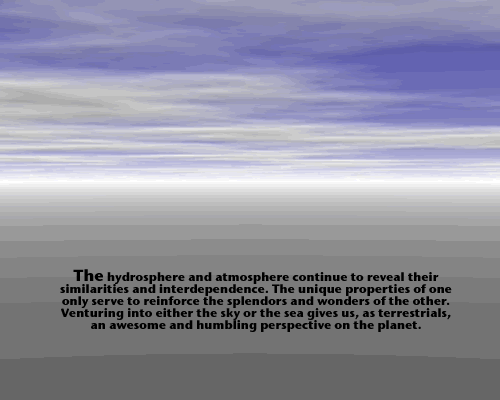
From a presentation delivered to SkyArt 2002 at the Helenic Ministry of Culture, Delphi, Greece.
I believe our ability to learn from and improve our behavior towards other individuals, groups and species is dependent upon an intimacy born of subtle and sublime encounter. The blending of art and science can help facilitate these encounters.

This project explores the possibility that humans and cetaceans (whales & dolphins)
can share aesthetic experience through sound, light and possibly haptics. It
is a kind of interactive sculpture garden for humans and cetaceans.
One of the key features involves concurrent presentation of acoustic and visual
signals. I hope to employ material that changes the color and or value of transmitted
light in response to the frequency of an acoustic signal.
This material is applied to an array of acoustic reflectors.
Individual reflectors are tuned to a different harmonic within the spectrum of
sounds produced in the space. As sound energy is reflected off the reflector
surfaces, the color of light passing through the mesh changes in response to
the acoustic signal. An array of these reflectors would be arranged to create
an acoustic, visual and somatosensory encounter zone.
Humans and cetaceans can play in and with the space. Eventually,
we might actually begin to jam and even dance with each other!
Is there a point to trying to make creative contact with cetaceans?
The notion that we could set up a situation conducive to creative expression
for both humans and cetaceans is speculative to say the least. To suggest that
non-human animals even engage in creative expression is provocative to a significant
portion of our culture. It is absolute heresy to some. It is at best a contentious
discourse.
None the less, most of us in this room have dedicated our lives to the prospect
that the artistic community can enhance the discourse, broaden the debate and
engage a wider community in the consideration of the unexpected.
Roger Payne, perhaps the preeminent
cetologist brought his amateur cellist’s aesthetic to bear when he first
identified musical structure in research recordings of humpback whale vocalizations.
Some of those first recordings were used by Paul Winter as inspiration and components
in his musical compositions. These evocations have captured the imagination of
scientists and nonscientists alike.
Musicians and sound artists like Lisa
Walker,
Jim Nollman and our colleague Richard Lerman among others have elicited observable
responses from groups of dolphins and other whales by playing music in the water.
Their recordings , web sites and writings engage wider audiences.
This musical realm enhances the possibilities in a compelling domain of inter
species interaction. The project I have in mind will add visual, and somatosensory
dimensions to the mix.
These kinds of evocations enhance our awareness of the beautifully ordered complexity
that characterizes the natural universe. Within this enhanced awareness may lie
the motivation for us to value and protect that which ultimately sustains life
on earth.
What makes me think that cetaceans are capable of creative expression?
In short, big well developed brains , extremely
well developed signaling ability ,very high degree of sociality and very high
adaptability.
Contemporary investigators attempt to evaluate any given behavior according
to how it contributes to evolutionary success of an organism. In the strictest
sense this translates into how a given behavior or anatomical feature increases
the probability that the genome will survive into the succeeding generation.
Implicit in this approach is the notion that a behavior or anatomical feature
evolved and persists according to the selective advantage it confers on an organism
in occupying a particular ecological niche. If it doesn’t contribute to
this advantage, eventually the feature recedes.
What is the selective advantage conferred by big, highly developed brains and high
bandwidth communication modalities?
And, why have these features persisted
for so long?
Why expend the energy to develop and maintain these big brains and stereophonated
echolocation bound to a highly developed dedicated acoustic
signal processor ?
One theory is that these features may contribute to maintenance of social
structure?
In many species sociability confers demonstrable advantages in foraging, defense
and procreation. Beyond simply “making a living” more highly developed
cognition may have evolved to negotiate more complex social environments.
The more complex the environment, the more adaptable the organism must be to
exploit the opportunities and challenges posed by the environment. In other words,
the richer and more flexible, indeed the more creative the organism’s
responses need to be.
Why not just leave it to the scientists?
Field scientist typically focus on a particular component of a subject’s
behavior. Over time a picture begins to emerge of a functional model of an animal
in its environment. Theoretically, science should be able to complete this picture.
This putative picture would establish the criteria from which to make a determination
of the intelligence of and the possibility of communication with whales.
The reality is that the picture shifts in focus and resolution. Scientific knowledge
despite scientistic protestation to the contrary, is ephemeral.
New observations change the image as well as the understanding of its meaning.
Yesterday’s laws become today’s conditional constraints.
The training of scientists focuses on methodologies that attempt to limit the
unexpected. Contemporary scientists prefer to focus on questions that hold high
potential for conclusive, quantifiable answers. This is of course an appropriate
and necessary condition for the progress of scientific knowledge. The “happy accident” is
an acknowledged but de-emphasized phenomenon in scientific research.
Artistic production and investigation, on the other hand, celebrates the happy
accident. Part of the “artistic method” involves setting up both the
external and internal conditions that increase the probability of happy accidents.
In short, the creative process involves exploring the domain of the unexpected.
We humans have arrived at a crucial juncture along the path of our tenure on
earth. We can continue down the path of exploitation and depredation or choose
to change our direction and start down the road of stewardship. For the dominant
cultures of our civilization the road to stewardship will require a fundamental
shift in thought and practice. We have profound lessons to learn ....
... nature has profound lessons to teach. We have some older classmates swimming
around who may be in a position to help us in our matriculation.
I believe that our collective as well as individual salvation rests in our legitimate
attempts at aesthetic gestures that transform the way in which we understand
and act in the world.
We may not see the day when whales tell us what to do with the world.
However if we are imaginative, reflective and considerate, they may help show us
how to be in the world.